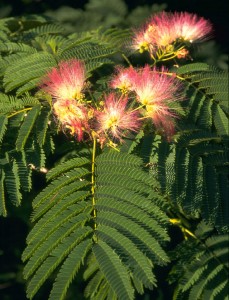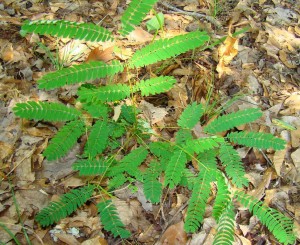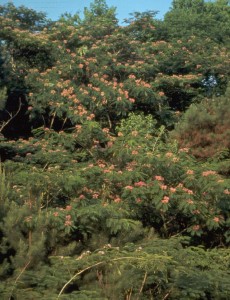Mimosa
Albizia julibrissin
Silk Tree, Mimosa
Native Origin: Eurasian in origin, found from Iran to Japan; also called Mimosa, Silky Acacia, and, rarely, Sensitive Tree, it was first imported into the U.S. in 1745 as an ornamental and remains popular with gardeners, due to its showy fragrant flowers, finely-cut foliage and ease of cultivation.
Description: A member of the Pea family, Silk Tree can grow 10 to 50 feet in height. Leaflets of the compound leaves will curl and close like pages in a book when handled. Numerous showy, powder-puff shaped flowers appear from June through August, and are followed by flat pods about six inches long that contain the large flat seeds. The seeds can persist for many years, and though the majority are dropped near the parent plant, seeds are eaten and passed on by animals and can be washed into streams and quickly disbursed to new areas.
Habitat: Grows and flowers best in full sun, but will grow in a variety of conditions. Spreads quickly to form dense colonies in disturbed areas. Often found along roadsides and near areas where it has escaped from cultivation, it can become a serious pest along streams where seeds are easily spread. Can reproduce both by seed and vegetatively; top-killed trees quickly re-sprout and re-grow.
Ecological Impacts: The dense stands of wild-growing silk trees quickly out-compete native trees and shrubs and shade-out native wildflowers and grasses.
Control & Management: Repeat controls may be required due to long-lived seeds and to repeat suckering from cut stumps.
Manual & Mechanical: Small seedling trees can be hand-pulled, taking care to remove the entire root system. Girdling of large trees can be effective: the girdle should be made about six inches above ground and should encircle the entire trunk in a deep cut that goes well within the bark. Treating the stump with herbicide will reduce re-sprouting; subsequent root sucker growths should be cut and treated with herbicide.
Chemical: Foliar treatment with systemic herbicide, such as Roundup, can be effective, but care should be taken to avoid non-target species. Herbicides, such as triclopyr, that act only on broad-leaf species may be preferred in locations with native or other desirable grasses. On sites near wetlands or streams, use of foliar herbicide treatment can adversely impact animal populations, and a combination of manual control, followed by minimal herbicide application to cut stumps may be best.
Comments are currently closed.



